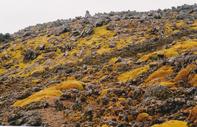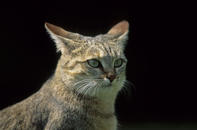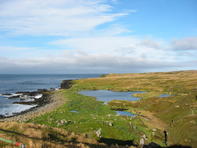The House Mouse
The natural system of Marion Island has taken several hundred thousand years to reach a self- perpetuating equilibrium. In just fifty years it is being thrown out of kilter.

The first import to noticeably disrupt the system was the house mouse, which arrived on the island with sealers in the 1800s. Mice feed on grass seeds and invertebrates - insects, arthropods and spiders - living in the vegetation.
Even outside the mires, the growth, death and foraging cycle of these invertebrates make an important contribution to the nitrogen requirements of some of Marion's plant communities. They also sustain the lesser sheathbill. Stellenbosch University botanist Professor Valdon Smith has been studying Marion for three decades.
He says a fifty per cent reduction in the sheathbill population has been recorded since 1976. A lack of food - invertebrates - owing to competition from mice is the most likely culprit.
This compares starkly with Prince Edward Island, which has a stable sheathbill population and no mice. Mice have made themselves at home across the island - mainly in the tussock grass - from the coast up to as high as the 750-metre contour. They thrive in summer and then die back in winter as the chill culls their numbers.
Without natural predators, it falls to the sub-Antarctic climate to keep the mouse population in check. Yet Smith says an increase in their numbers has been observed since the sixties. As conditions become warmer and more favourable to their survival, their population is expected to boom at the expense of the locals.
The Cat Arrives

After annexation, mice became such a pest that some of the first settlers shaved their heads - in spite of the cold - because the mice kept nibbling at their hair at night. In a flush of good intention, five cats - a single female, a neutered male and later three kittens - were brought to Marion Island in 1949 to tackle the mouse blight.
Within two years, the cats' offspring had gone feral. By 1975, 2 000 cats roamed the island, by which time they had discovered that birds were far easier prey than little rodents hidden in the undergrowth. The island's burrowing bird population was hardest hit.
In that year alone, the cats managed to eat 'just under half a million birds, resulting in the extermination of the common diving petrel and the near extinction of three other species of petrel.
By the 1980s it was time to take on the cat population. It took five years, innumerable man-hours, traps and nocturnal hunts but, by 1991, the last cat had fallen. Some twelve years later the burrowing petrels are returning, bringing with them the nitrogen from their guano that supports so much plant life.
Recovering Ecosystem

In April 2003 Gremmen and Smith noted an increase in the amount of tussock grass found near the coast. Good news, they confirm, because it indicates a recovering ecosystem. Even so, the bird numbers pale compared with Prince Edward Island, which never lost birds to the unwelcome felines.
There the burrowing petrel communities are so strong that Gremmen and some colleagues who enjoyed a rare visit to the island in 2003 had trouble sleeping at night because the vocal night birds were so numerous. Many of the plants and animals on Marion occur nowhere else in the world.
As the climate changes and alien species flourish, indigenous plants will be out-competed and extinctions will occur. Like extinctions, states Gremmen, the introductions of alien species are forever. You can disrupt an area and nature will recover, even if it takes fifty years or five hundred. But if you introduce an alien species there is generally no going back.
Now that the cats have been removed, and the impact of the mice has been understood, and as fears of global warming grow, South African researchers have realised the value of Marion Island for mapping the impact of climate change on plant and animal communities. Local species have evolved in extremely chilly conditions, so everything about them seems to be on a go-slow.
While a house fly in South Africa will hurry through a full life cycle - emerging from an egg to becoming an egg-laying adult - in just four days, Marion's kelp fly will take six months to a year to get through the same stages of life.
A weevil takes a year, which is much slower than a warmer climate weevil. Marion's flightless moth, Pringleophaga marioni, also trundles through its lifetime.
A female Pringleophaga moth will lay forty to fifty eggs that will hatch after about a month, which is a relatively slow incubation period for moths. When the caterpillars emerge, they will set upon local vegetation with relish - and continue to do so for the next four to five years. Only then will they pupate and set about the business of becoming adults.
Invasive Species

Invasive species are high-octane breeders. Having evolved in warmer climes, yet still able to withstand the southern chill of Marion, they rush through their life cycles. The exotic springtails, cabbage moths and blow flies cover three to four times the number of generations per year than their indigenous counterparts.
More significant, however, than the relative speed - or lack of it - of the exotics versus the locals, is their response to increasing temperatures. Exotic species, already on the gallop, respond quickly to an increase in temperature and so get through even more generations than before. Indigenous species respond slowly to temperature increase.
Consider exponential increases and you will get the picture. Before long, Marion will literally be crawling with foreigners. In the long term it means there may well be more litter recycling and nutrient production - signifying more food for the plants.
But huge increases in the number of alien species will reduce the amount of peat formed in the mires, challenge the indigenous species at their own game, and entirely change the functioning of the system.
By Leonie Joubert